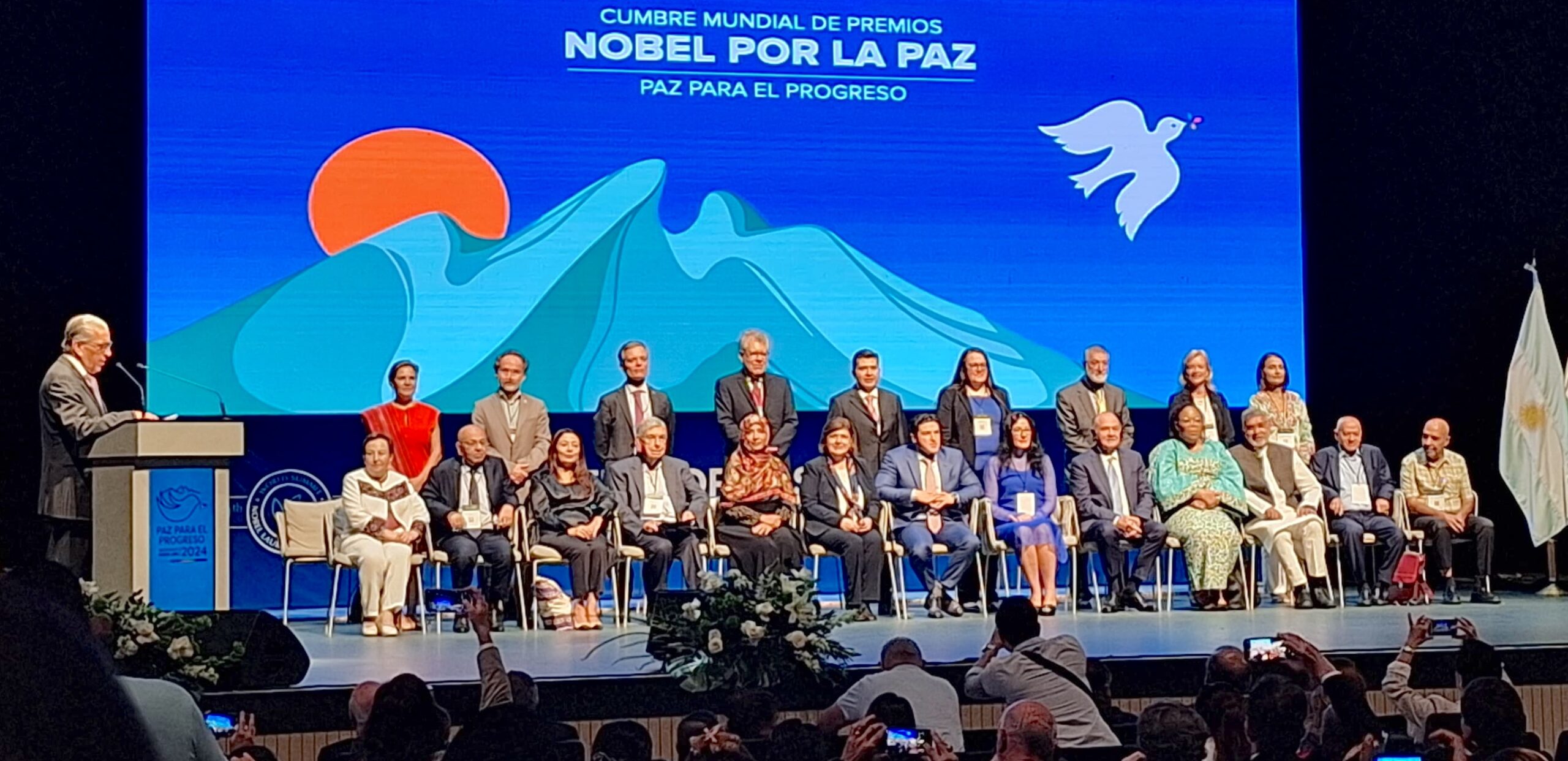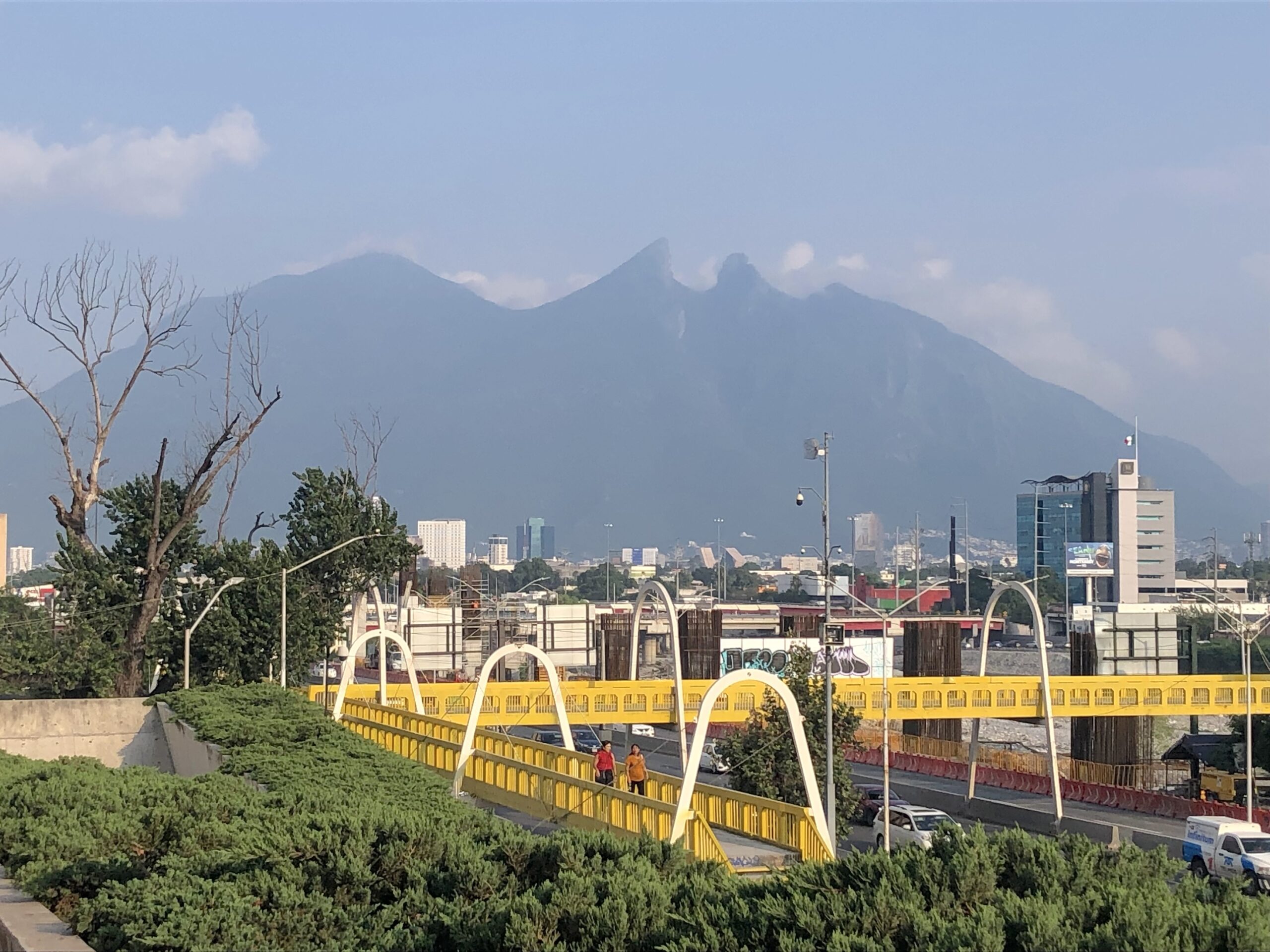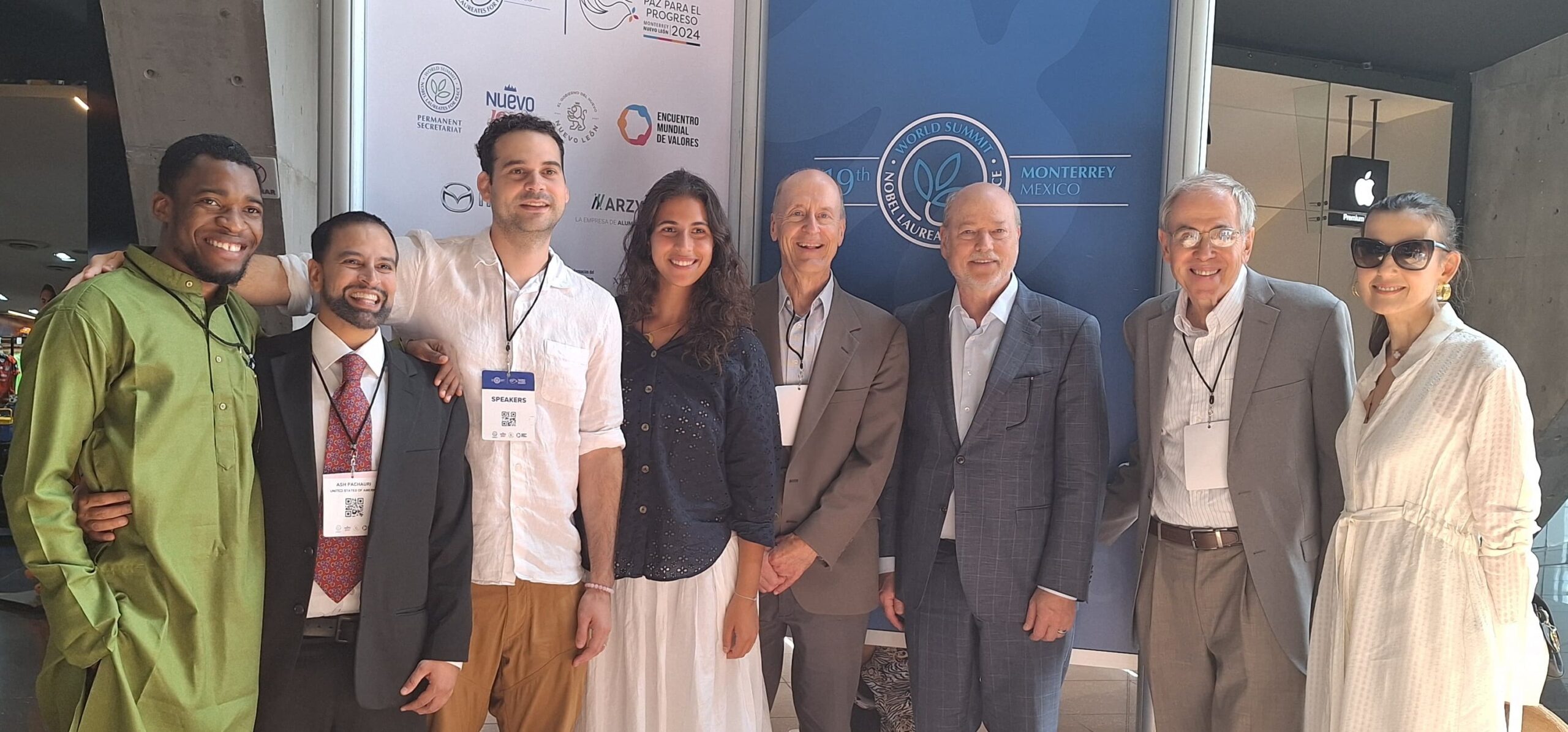
President Hagelin addresses the World Summit of Nobel Peace Laureates; faculty and students also give presentations
At a global event that brought together 15 Nobel Peace Prize winners, renowned leaders of peace organizations, distinguished academics, and more than a thousand university students from around the world, MIU President John Hagelin presented a “brain-based approach to peace” that offers a scientifically-validated, field-tested, low-cost solution to the perennial problem of war and violence in the world.

It was a timely and powerful presentation. Previous speakers had stressed that the world is now closer to nuclear war than at any time in history and that the challenge before us is immense.
The gathering was the 19th World Summit of Nobel Peace Laureates, held in Monterrey, Mexico, September 18–21.
This annual event, internationally recognized as one of the most important gatherings in the field of peacemaking, brings together Nobel Peace Prize winners and others to tackle global issues and promote peace and human thriving. Launched in 1999 by Mikhail Gorbachev, who had won the Nobel Peace Prize in 1990 for his role in helping end the Cold War, the Summit celebrated its 25th anniversary in Monterrey.
The Summit was structured around seven key themes related to peace, with panel discussions led by Nobel Peace Laureates and other peace leaders. Dr. Hagelin was invited to speak during the closing, summative panel, entitled “Global Peace: Time to Act.”
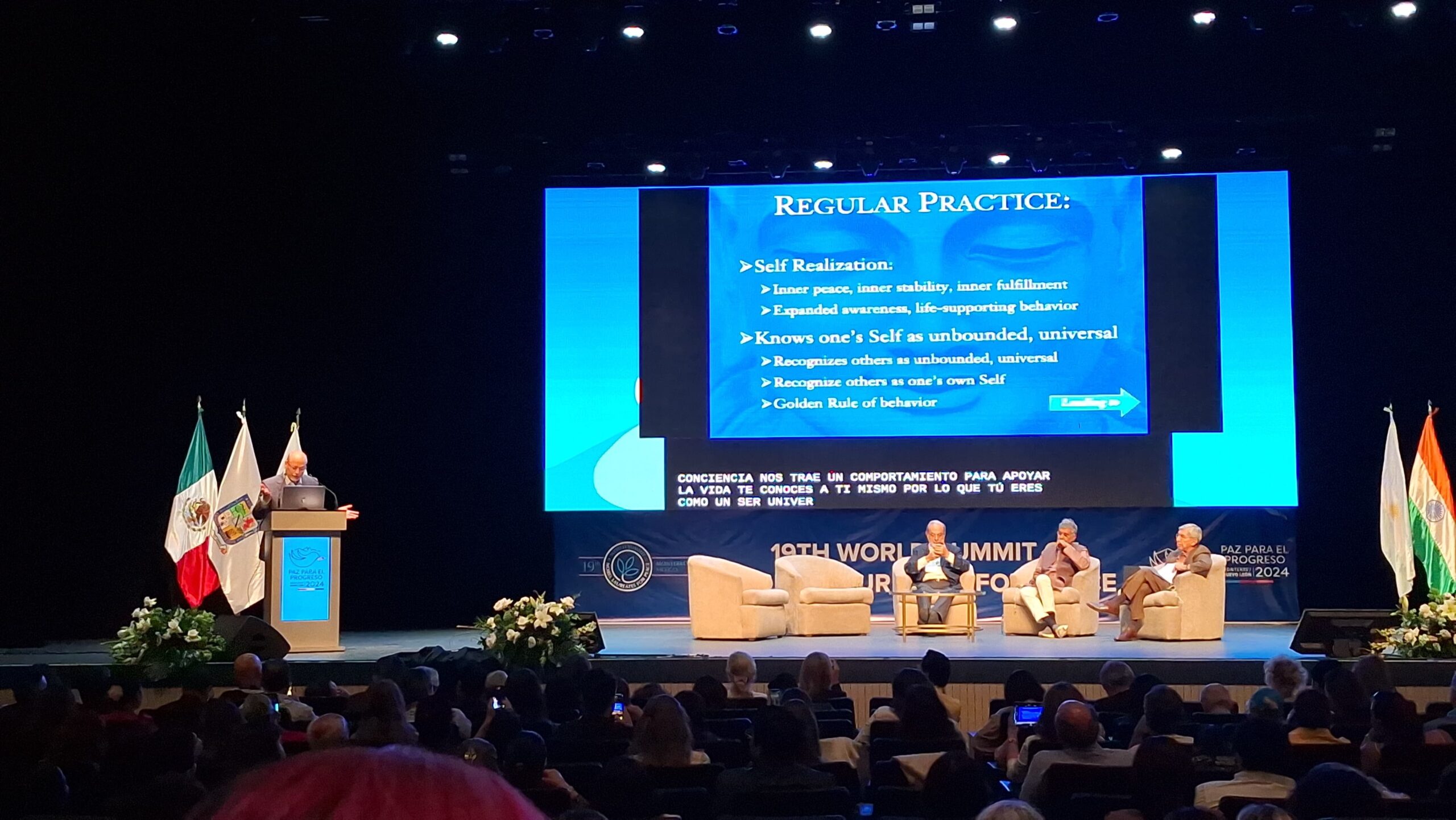
World peace through inner peace
The precursor to war and violence, Hagelin said, is stress. Stress in the individual shuts down the prefrontal cortex — the higher brain — while stimulating the amygdala, triggering the body’s fight-or-flight response. Mounting stress is causing ill health, psychological distress, depression, anxiety, and rising levels of social violence throughout the world.
The traditional approach is to try to reduce the stressors — oppression, poverty, injustice, prejudice, and so on. But this has proven difficult if not impossible, he said. But there is a way to directly reduce the stress itself and thereby reduce violent behavior.
Hagelin reviewed studies showing how the Transcendental Meditation technique has been used in prisons to markedly improve prisoner behavior and reduce recidivism, and how the Pentagon has used it to significantly reduce PTSD in veterans.
Then he showed how the same effect can be leveraged through large meditation groups to reduce stress throughout society.
“The first stage in the emergence of war,” he said, “is mounting social stress — acute political, ethnic, and religious tensions in critical hotspots throughout the world. These mounting tensions, if left unchecked, frequently erupt into social conflict.” Traditional efforts — ceasefires and negotiated settlements, for example — typically yield only fleeting relief. Because they don’t reduce the underlying stress, they fail to provide a stable basis for lasting peace.
In contrast, Hagelin summarized studies demonstrating how this brain-based or consciousness-based approach reduced violent crime in Washington DC by 23% while improving the quality of life for the whole city. And he described how the same approach dramatically reduced the intensity of the Lebanese Civil War in the early 1980s, with seven different studies confirming this effect.
Altogether 55 studies on this effect, known as the Maharishi Effect, have been published in peer-reviewed journals or conference proceedings. The effect has been demonstrated all over the world and at every scale of society, from cities to states and from countries to the world as a whole.
“No other approach to peace in history, as far as I know, has had a comparable track record of success,” Hagelin said. “And this particular approach to peace is not that difficult. It’s relatively easily and cost-effectively implemented in schools and colleges” as well as in the military and in police training.
“Even a small fraction of a population produces demonstrable results,” he said, adding, “It has been very effective in Mexico itself in certain school programs here.”
He then described how the effect works — how Transcendental Meditation practice allows the mind to settle effortlessly inward to its basis in pure consciousness, which is identical with the unified field, understood in quantum physics to lie at the basis of all change throughout the universe.
“Meditation expands consciousness,” Hagelin said. “It takes our scattered mental activity, our disorderly EEG, and transforms it into coherent brain functioning.” Coherent brain functioning in turn is correlated with high IQ, learning ability, memory, intelligence, creativity, and moral reasoning.
“Regular practice of meditation brings inner peace, inner stability, inner fulfillment, inner contentment,” he said. “It brings life-supporting behavior.”
As a result, he said, “You know yourself for what you really are — unbounded, universal being. And you recognize others as unbounded universal beings — you recognize others as your own self. That brings the golden rule of behavior. And that brings a peaceful world. This is world peace through inner peace, an evidence-based, scientifically proven process.”
This is the central approach to peace recommended by the Global Union of Scientists for Peace, founded by Dr. Hagelin to help prevent of terrorism, war, and social violence through cutting-edge, field-tested solutions in the areas of conflict resolution, national security, and global peace.
Click here to watch Dr. Hagelin’s talk.
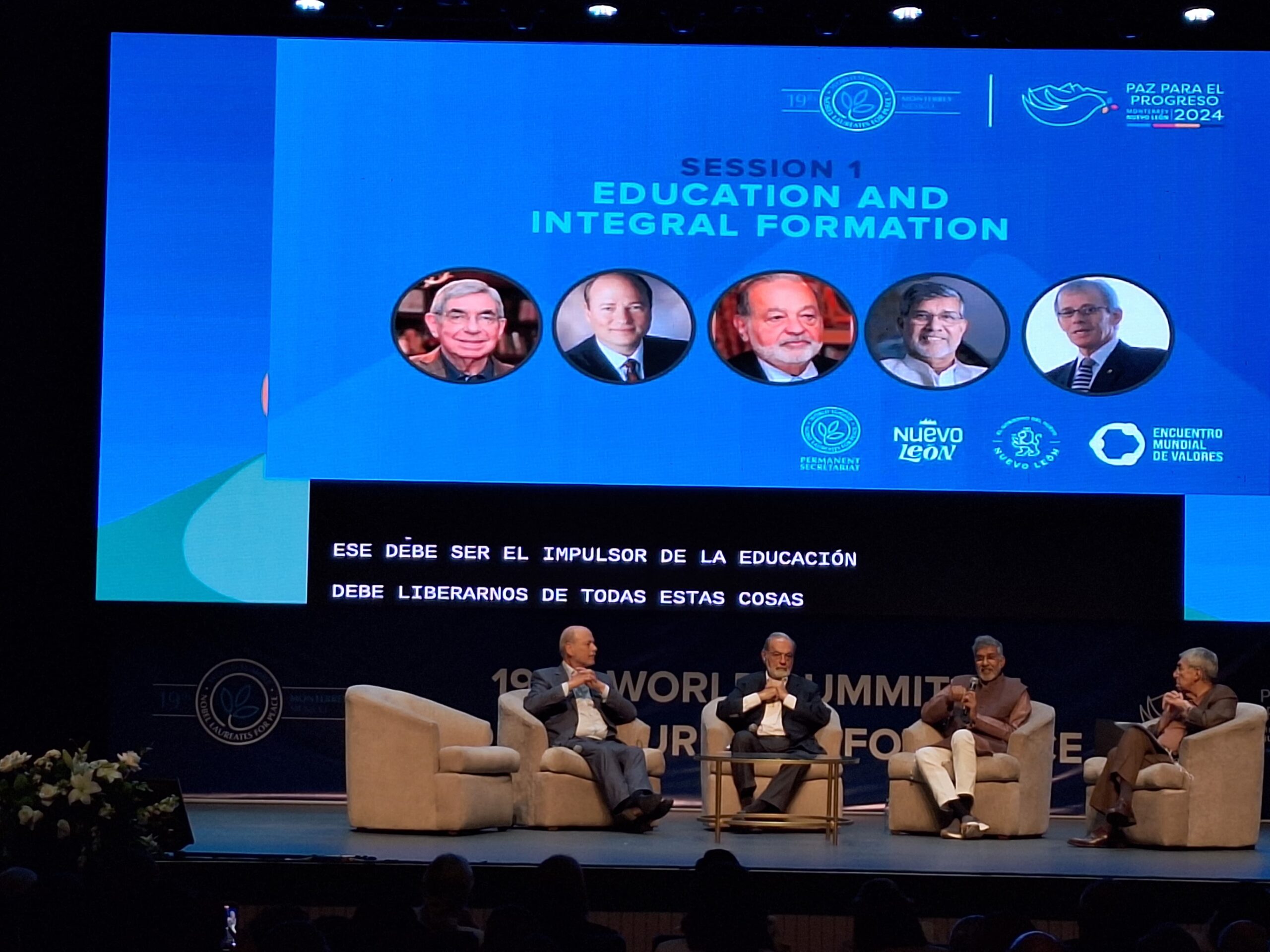
Hagelin’s panel also included, as pictured above:
- Carlos Slim, the Mexican business magnate, investor, and philanthropist, ranked as the wealthiest person in Latin America and the 11th wealthiest in the world, according to Bloomberg (he was ranked #1 from 2010 to 2013 by Forbes), with a net worth of $105 billion. His foundation focuses on support for education.
- Kailash Satyarthi, the Nobel Peace Prize winner in 2014 along with Malala Yousafzai, for efforts to ensure child education and prevent child suppression. He presaged Hagelin’s talk by saying that consciousness is the foundation of life and that education is the birthright of all children.
- Óscar Arias Sánchez, the former President of Costa Rica, who won the Nobel Peace Prize in 1987 as the architect of a peace accord also signed by Guatemala, El Salvador, Nicaragua, and Honduras, designed to end the long-raging civil wars in those countries. He also won the Albert Schweitzer Prize for Humanitarianism and has been awarded fifty honorary degrees.
After his presentation, Hagelin was able to speak with Dr. Karen Hallberg about collaboration. Hallberg, a prominent Argentinian physicist who also spoke at the Summit, has just been appointed Secretary General of the Pugwash Conferences on Science and World Affairs, an international organization founded in 1955 that brings together scholars and other leaders in pursuit of a world free of nuclear weapons and other weapons of mass destruction. The organization won the Nobel Peace Prize in 1995 for its work on nuclear disarmament.
Dr. Hagelin had given two very short prerecorded talks at the previous World Summit of Nobel Laureates for Peace, held in December 2022 in South Korea. The distance and times involved precluded him from attending in person or speaking live. But this time it was a major talk during the highest-profile panel.
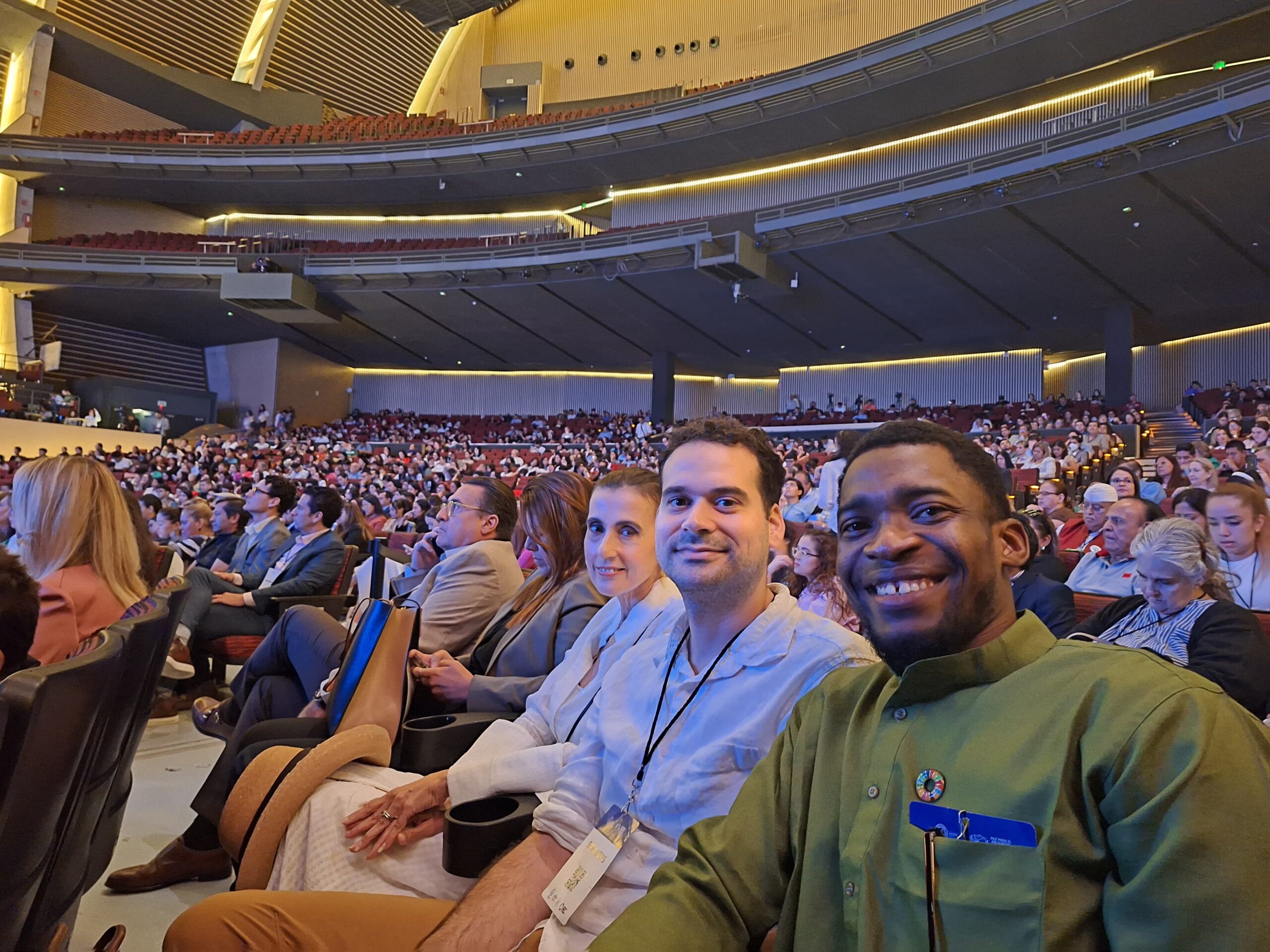
Faculty workshop
MIU faculty members Craig Pearson and Gerry Geer presented a workshop on the same theme. Entitled “Close Your Eyes and Change the World: The Extraordinary Possibility of Creating Positive Change Through Meditation,” this was one of about 15 workshops held during the Summit, concurrently with the main Summit panels.

“We had no idea whether anyone would come to our workshop, since the Nobel Laureates were hosting a Summit panel on peace education at the same time — and other workshops were taking place then too,” Geer said. “So we were delighted that about twenty people showed up, all college students.”
“They were all engaged and excited,” Geer said. “At the end of our talk they wanted to take a group photo, and several asked for selfies with us. Even our Spanish translator was inspired, since she remembered hearing about the Washington DC study in 1993.”
MIU student presentation
Three MIU students — Sam Okorie, Dylan MacDonald, and Muna Askar — created and presented a proposal for a “Peace Lab,” described as “a platform for youth from around the globe to present innovative projects and startups in the realm of peace.”
Entitled “Art and Science of Peacebuilding through Technology of Consciousness,” their proposed project had four components:
- Cultivate a global network of youth peace ambassadors equipped with the skills and knowledge to promote peace in their communities.
- Establish the MIU Peace Lab as a leading center for mentorship, capacity building, and knowledge dissemination in the field of peace-building through technologies of consciousness.
- Develop a user-friendly digital platform to facilitate youth exchange programs, knowledge transfer, and global collaboration in peacebuilding efforts.
- Provide a virtual space for conflict resolution and mediation, leveraging the transformative power of meditation to foster peaceful dialogue and understanding.
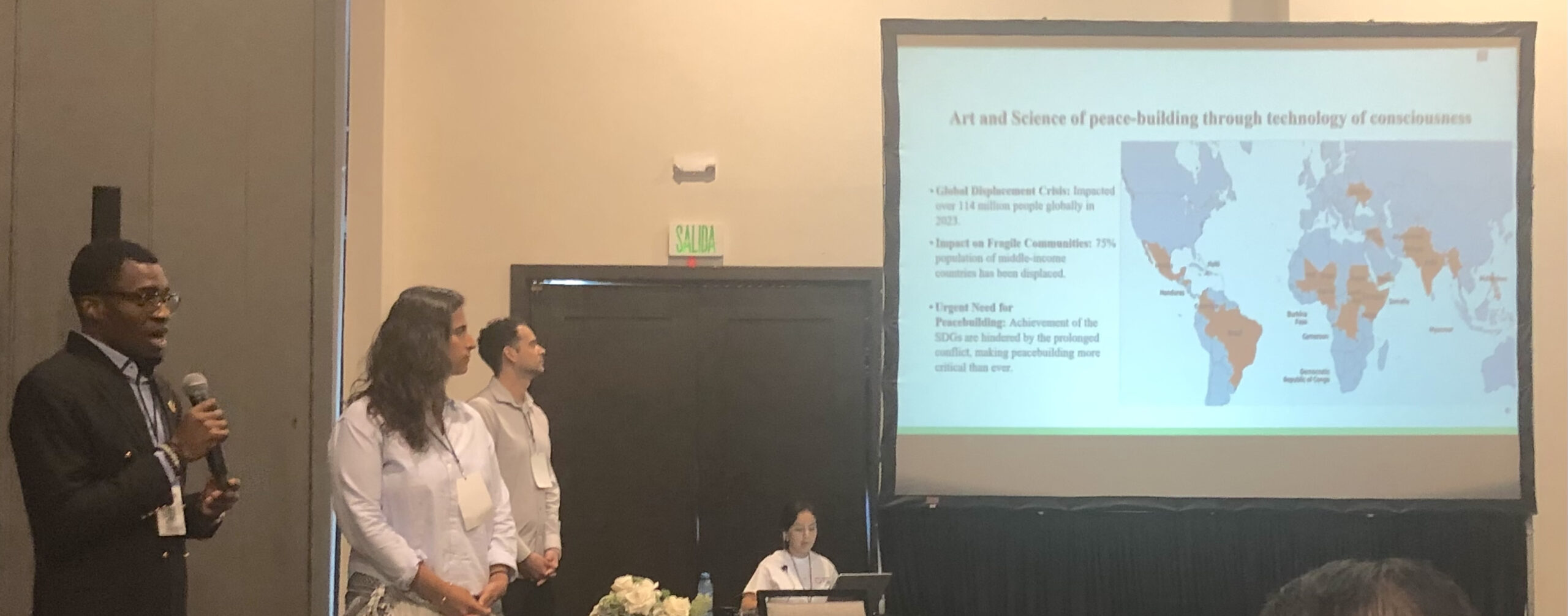

Muna Askar is an undergraduate student in the Regenerative Organic Agriculture program and one of the chief organizers of the annual Harvest Festival, to be held Saturday, September 28.
Dylan MacDonald graduated cum laude last June with a BA in Enlightened Leadership and was named that program’s outstanding student along with receiving a Development of Consciousness award. He has just started the master’s program in Enlightenment and Leadership.
Sam Okorie, from Nigeria, recently completed the MBA in Sustainable Business and is now a student in the PhD in Management program. Already well known internationally as a climate activist before coming to MIU, he had spent three days in Bonn at the beginning of September in his role as a member of the Advisory Board of the United Nations Framework Convention on Climate Change (UNFCCC) Santiago Network, where he represents children and youth globally, helping ensure that they and other vulnerable groups receive the support they need in the face of loss and damage associated with climate change impacts. Prior to Bonn he had spent time in Geneva, Switzerland, in the same capacity.
Also present at the Summit was Dr. Ash Pachauri, founder, director, and senior mentor of the worldwide POP (Protect Our Planet) movement, who was MIU’s commencement speaker in 2022. It was Pachauri, the senior advisor of environmental security in Dr. Hagelin’s Global Union of Scientists for Peace, who first connected MIU with the World Summit of Nobel Peace Laureates.
MIU participants’ experiences
“Coming to the Peace Summit in Monterrey with the knowledge that we have as meditators felt like we had some secret answer that we were tasked with bringing to conference,” MacDonald said. “People asked many questions and repeatedly brought up many problems, and I felt it was our responsibility to let it be known that we actually have a solution. This feeling empowers you, not in a way that makes you feel greater than others but that makes you want to connect with these brilliant and selfless people and allow them to see the light emanating from within.”
“The most fulfilling highlight for me,” Geer said, “was seeing our own President Hagelin step out onto the Summit stage to address all the Nobel Peace Laureates and the thousands of attendees about our proven, innovative approach to peace — a truly appropriate setting for this life-changing knowledge. Equally inspiring was the passionate, heartfelt commitment of all those Laureates and attendees to the cause of peace. This historic Summit will no doubt change the world — and lead to many collaborations on peace projects between MIU and the Summit attendees.”
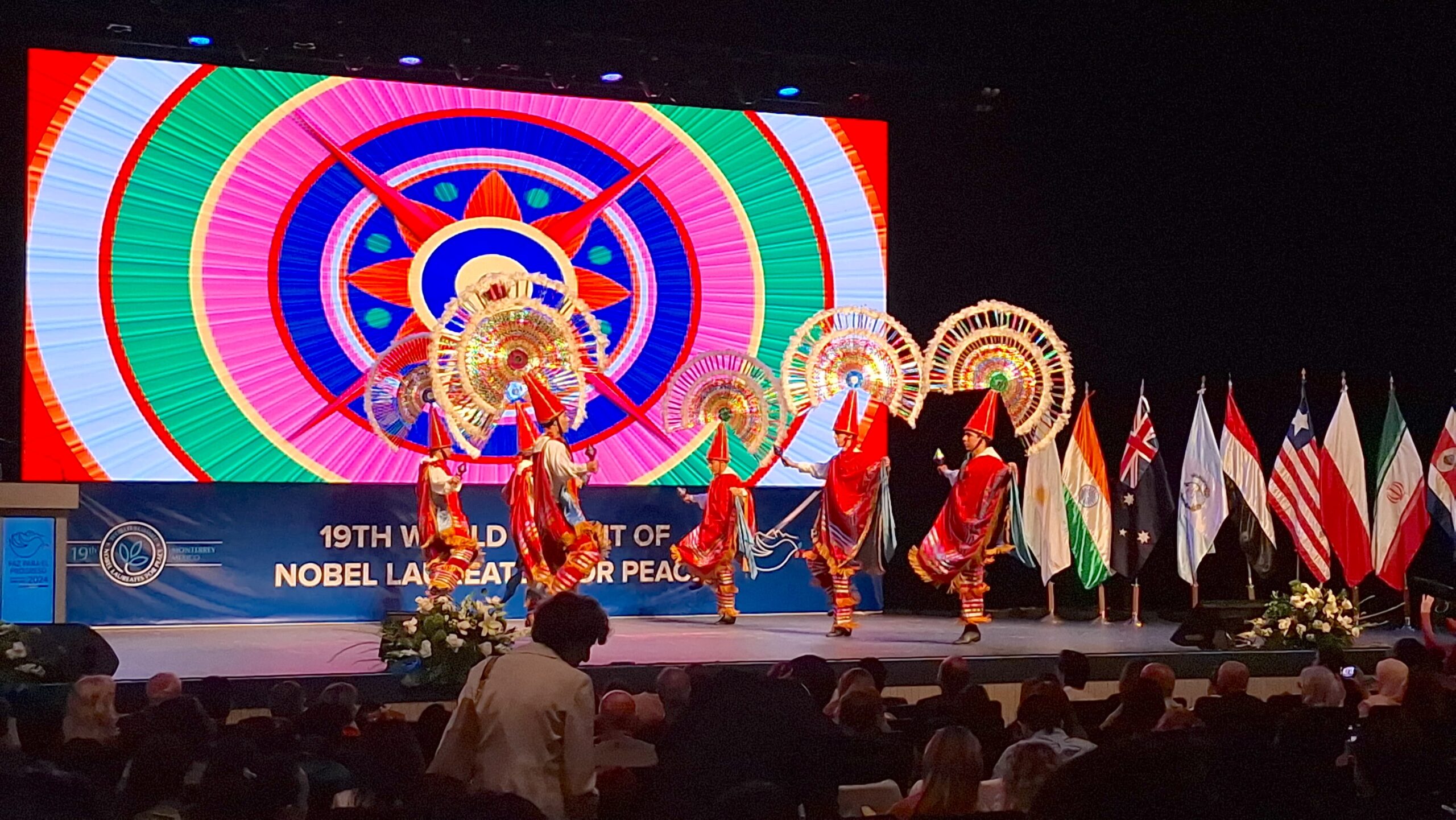
Interview with Muna Askar
Overall, what was it like to be a participant in this global event?
“I feel incredibly inspired by the gathering of people from all fields of life, all ages, from all over the world. With passionate young adults dominating the crowd, the future is in bright hands.”
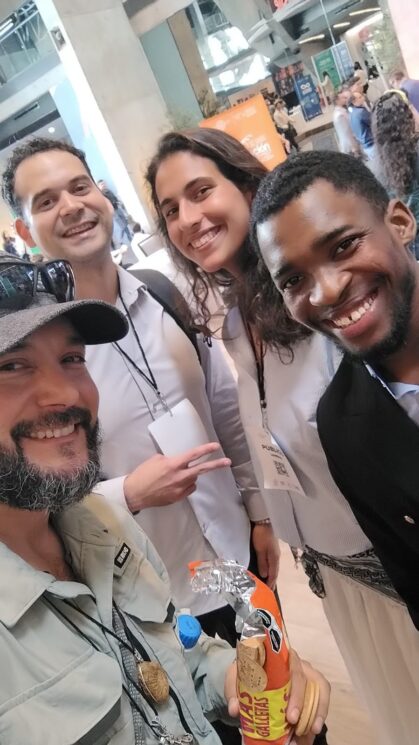
What was your impression of the Nobel Peace Laureates and other peace leaders?
“The Nobel Peace Prize Laureates and other activist leaders acknowledged the present conflict in the world. Their words were filled with rightful grief and anger towards the suffering they witness. The call to action was one of awareness through education, sharing information, and being relentless in hope and strength.”
Do you feel they presented practical solutions?
“There seemed to be a lopsided quality leaning towards problems rather than solutions. Needless to say, I was disappointed at the lack of understanding of the root of the problem. It wasn’t until Dr. Pearson and Dr. Geer gave a captivating presentation on the Maharishi Effect with a crowd full of college students who ate it up. One woman came up to me afterwards practically begging for this to be shared with students all over Mexico, wondering how she could access this information to open the minds of her peers to this solution.”
What was it like to be in an audience of 1,500 people when President Hagelin presented the model of consciousness?
“It warmed my heart to see youth all around me engaged and affirming their support in this truth, further empowering my commitment to transcending as a worldwide peacemaking technology. I am so grateful to have received the opportunity to have this experience with such a brilliant group. Transcendental Meditation continues to be the simplest path towards world peace.”
